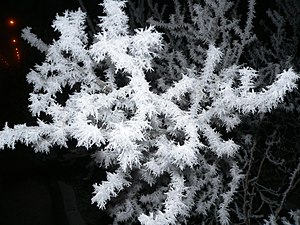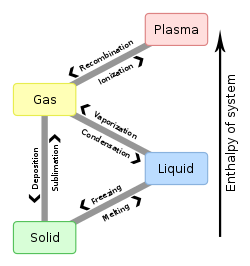
Back Kristallisering Afrikaans تبلور Arabic Cristalización AST Крышталізацыя Byelorussian Кристализация Bulgarian কেলাসীভবন Bengali/Bangla Kristalizacija BS Cristal·lització Catalan Krystalizace Czech Kristallisation German



Crystallization is the way that atoms link up in a regular structure. The structure is held together by chemical bonds or connected groups. Crystallization can be from a melt or from a solution, and can be natural or artificial. Rarely, crystal can form directly from a gas. Faster crystallization makes smaller size crystals as in basalt, and slower can make bigger crystals, as in granite.
Crystallization occurs in two major steps. The first is nucleation. This is the appearance of a crystalline phase from a super-cooled liquid or a supersaturated solvent. The second step is crystal growth, where more atoms link up with the crystal structure. This means the (crystal) particles get bigger; this leads to a crystal state. Loose particles form layers at the crystal's surface and lodge themselves into open pores, cracks, etc.
Artificial crystallization is a technique to get solid crystals from a homogeneous solution. For crystallization to occur the solution should be supersaturated. Put simply, the solution should contain more solute molecules than it would under ordinary conditions. This can be achieved by various methods—solvent evaporation, cooling, and chemical reaction.
To make things clear we can use a simple example. We take a bowl of water to which we add sugar crystals. We keep adding sugar to it until we reach a stage when no more crystals can be dissolved. This solution is now a saturated one. It is interesting to note that we can dissolve more crystals to this particular saturated solution by heating it. Solubility of solutes increases with increase in temperature, but there are exceptional cases. This increase in temperature causes more sugar crystals to dissolve (so forming a supersaturated solution). When the temperature of the solution cools down, the solubility goes down, i.e. not as much sugar can be dissolved, so the extra sugar crystallizes out. This process is one of the simplest supersaturation techniques.
'Drowning' is the addition of a non-solvent in the solution that decreases the solubility of the solid. Alternatively, chemical reactions can also be used to decrease the solubility of the solid in the solvent, thus working towards supersaturation.
Crystallization can be divided into stages – primary nucleation is the first. It is the growth of a new crystal. In turn this causes secondary nucleation – the final stage if removal of the crystals is not an issue. Secondary nucleation needs existing crystals to continue crystal growth. In our sugar example, we had got such nuclei when the 'excess' sugar had just about crystallized out. Secondary nucleation is the main stage in crystallization for this is what causes the 'mass production' of crystals. Crystals start to form when the liquid starts to cool and harden.
